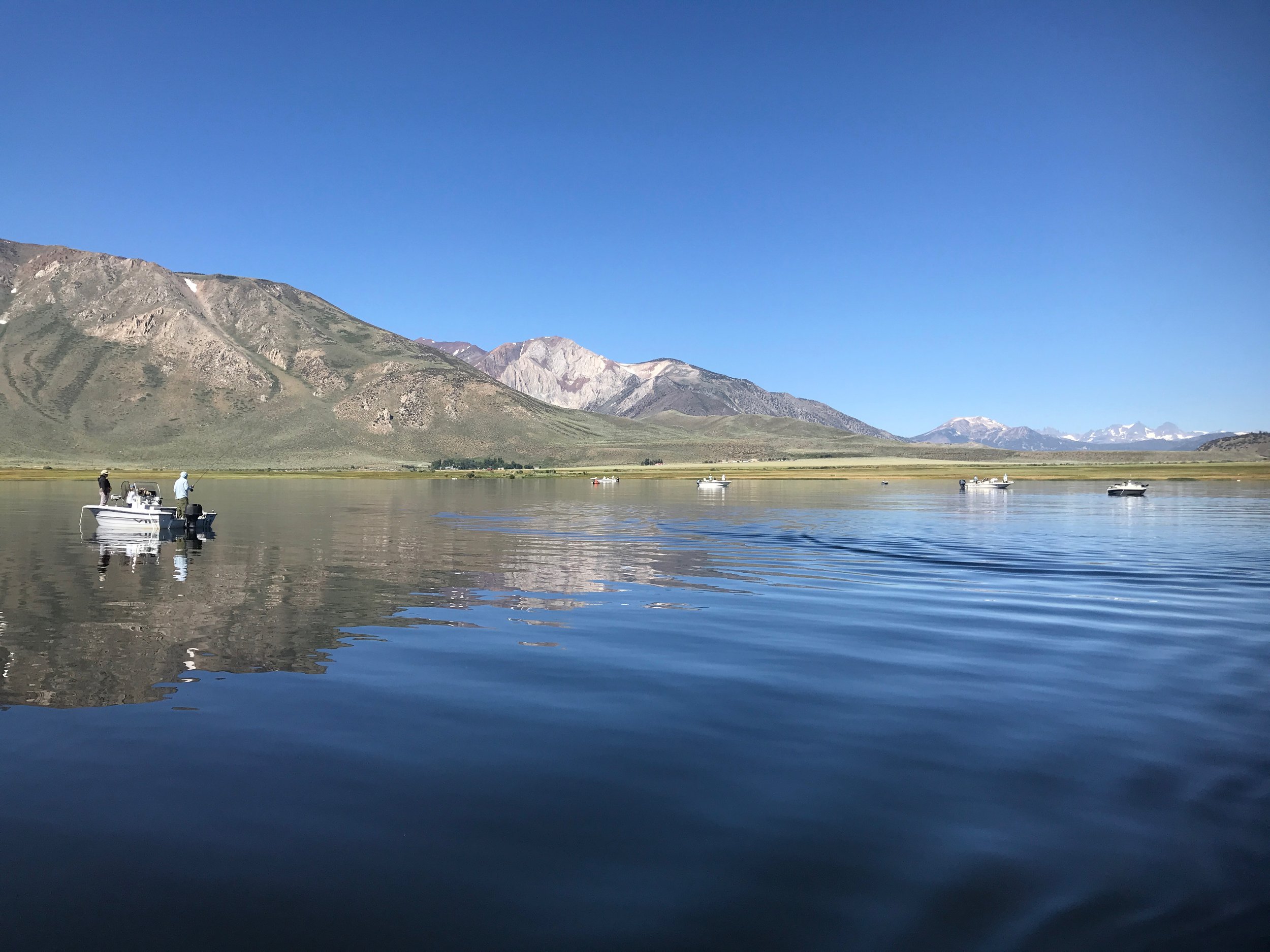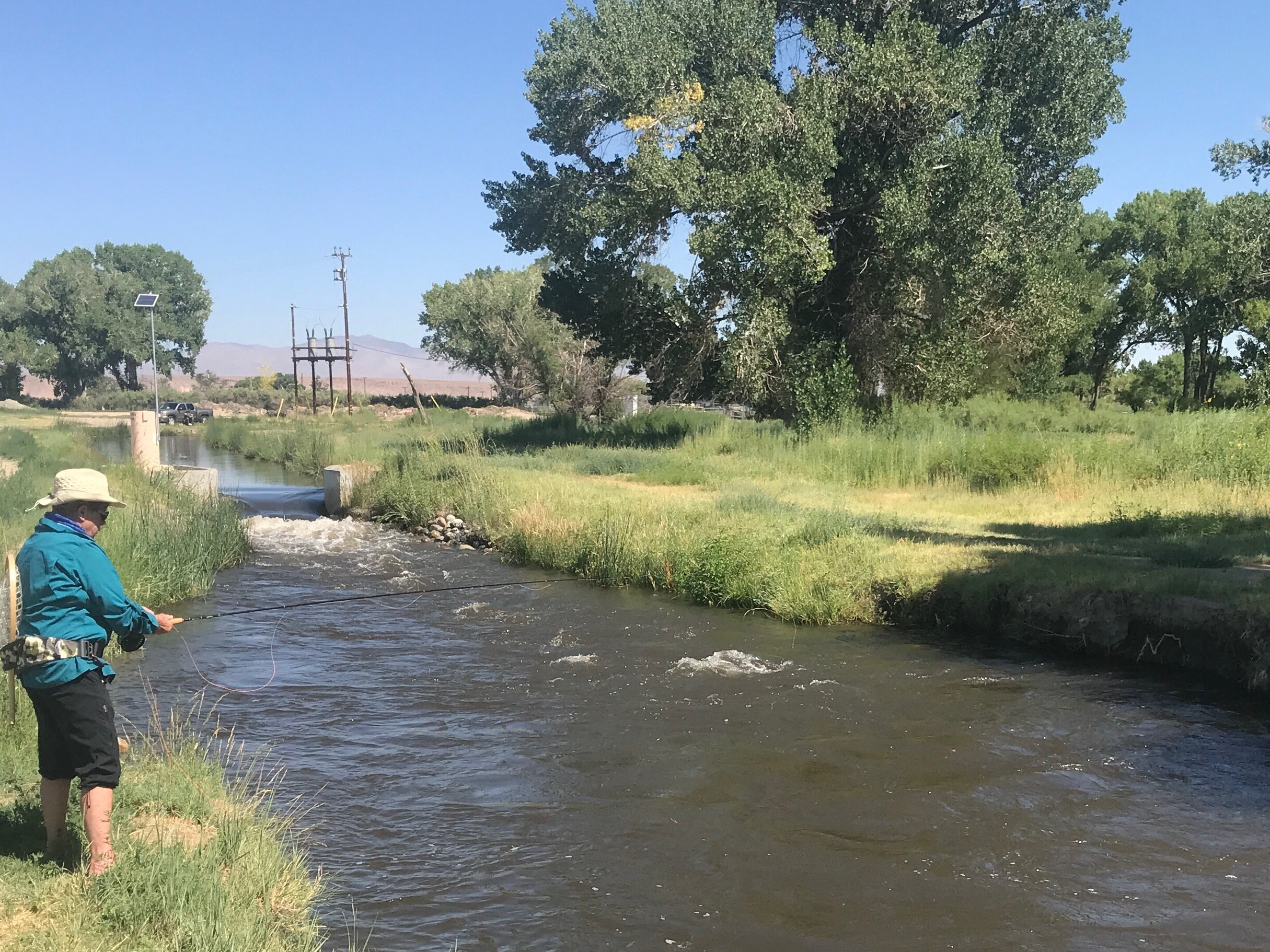With peak runoff behind us fly fishing opportunities on Eastern Sierra waters are improving every day. Freestone creeks are still flowing above normal, but fly fishers are finding more safe spots on the creeks to fish. Nymphing continues to be the most productive method of fly fish right now. Hatches are intensifying and trout are just starting to come to the surface to feed on emerging insects. Mayflies, caddis, midges, and the occasional hopper are what the trout are feeding on. Lakes are full and stabilizing offering fly fishers great opportunities to fly fish their favorite still water. With the receding water mosquitoes have lighten up on most waters.
Flows on McGee Creek are still above normal for this time of the year and require anglers to fish with cation while fishing from the banks .
Lower Owens River
Wild Trout Section:
Mayfly nymphs and hydropsyche caddis are what the trout are feeding on. With flows just under 300 CFS the lower Owens River is fly fishing well right now. I’m fly fishing it with the Euro rig and finding six to 10 inch wild browns willing to take my hot spot pheasant tail nymph, stoner nymph and green/gold Prince nymph. Under an indicator I use bead head flash back gold ribbed hare’s ears, bead head flash back pheasant tail nymphs and olive burlap caddis. I’m cautious where I’m walking on the banks as they are still unstable from the high flows.
An eight inch wild brown trout that took the stoner nymph fished in a pool just upstream from Five Bridges Road.
Hot Creek
Interpretive Site:
The creek is in good shape if you want to fish nymphs. There is a morning trico mayfly hatch, but the trout are not coming to the surface to feed on the duns and spinners. Bead head flash back pheasant tail nymphs, bead hear flash back gold ribbed hare’s ears, hot spot pheasant tail nymphs, Frenchie’s and olive quilldigons are fooling the wild trout. Fishing has been steady all day with enough trophy trout to make it a fun day on the creek fly fishing.
Roman Saroyan cast a size 18 bead head flash back pheasant tail nymph under an indicator to this 16 inch wild brown trout and watched it take the fly.
Hot Creek
Canyon Section:
Receding flows and clear water is allowing fly fisher in Hot Creek Canyon to catch wild trout on nymphs. Most of the canyon section is still too fast. Fly fishers working their nymphs behind structure like weed beds and rocks or fishing the slower sections in the canyon are catching trout. Conditions right now are perfect for Euro nymphing in the canyon with hot spot pheasant tail nymphs, stoner nymphs, scuds and olive burlap caddis. Dry fly fishing in the canyon is pretty much nonexistent right now.
Right now is the perfect time to be learning how to Euro nymph on the upper Owens River like Bill Chappelear from Scotts Valley and Troy Depuyot from Santa Cruz did.
Upper Owens River
Above Benton Crossing Bridge:
Water levels are at 90 CFS above the confluence of Hot Creek. The river is in perfect shape and is producing trout on nymphs, dries and streamers. I’ve been teaching Euro nymphing to clients. In the morning they’re learning to lead the flies, take in slack and elevate or lower the rod tip to keep the rig, sighter, taught. In the afternoons when the fly fisher can keep the line taught they are catching five inch to 20 inch rainbows and browns on hot spot pheasant tail nymphs, stoner nymphs and green/gold Prince nymphs. There are a few hoppers around, but the trout are not keying in on hoppers yet. Horse flies are prevalent at the parking areas and mosquitoes middle of the day are few and far between. Using elk hair caddis and trico spinners are producing trout for fly fishers wanting to dry fly fish.
The flotilla of boats is fishing 10 to 15 feet of water in the north west corner of McGee Bay.
Crowley Lake:
The lake is at full pool. Highest I’ve seen it in my 44 years in the Eastern Sierra. The lake has stabilized and fly fishers are finding trout in the north west corner of McGee Bay. The fish are in 10 to 15 feet of water and are taking tiger midges, zebra midges, gray midges and albino midges. As the day progresses the midges move high up in the water column as they begin their ascent to the surface to hatch. I start off the morning working my midges within six inches of the substrate. By the time the wind comes up around 11:00 A.M. I’m fishing my nymphs as much as four feet off the substrate. Key to success is finding areas where there is an abundance of midges hatching.
Euro nymphing has been the most productive method to fly fish Bishop Creek Canal.
Bishop Creek Canal:
Behind the Old Ford Dealer:
Mid-day temperatures in the mid 90’s has made fly fishing Bishop Creek Canal tolerable. I’m Euro nymphing with a hot spot pheasant tail nymph, stoner nymph and green/gold Prince nymph. The stocked rainbows like flashier flies like the two tone Prince, rainbow warriors, lightning bugs and orange scuds. The trout are not in the normal spots that usually produce. They are concentrated in the slower runs or on the edges of the very fast water sections.






